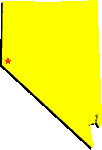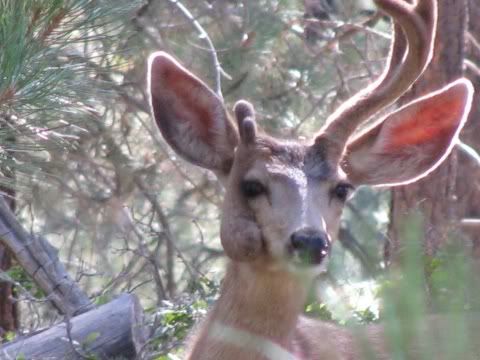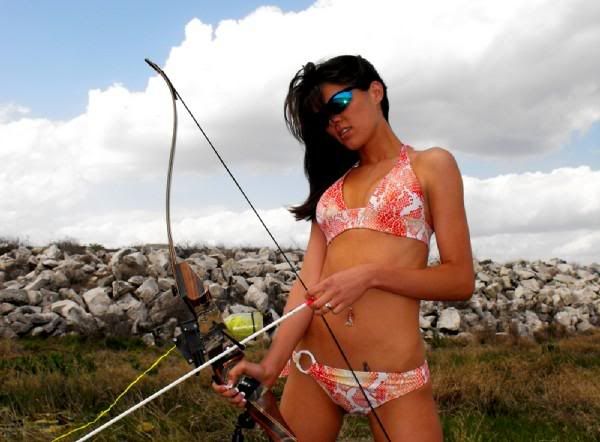
Northern Region
Archery hunters should see more deer in northern Utah this fall.
“The number of deer has increased following a mild winter and a wet
spring and early summer,” says Randy Wood, regional wildlife manager.
“Hunters should see more yearling bucks this fall.”
Wood reminds hunters that the Northern Region includes large chunks of
private property. “It’s a good idea to get written permission from
landowners before planning a hunt to an area that has private
property,” Wood says.
Wood says pre-season scouting will improve your success. “And please
remember that you’re hunting in bear country,” he says. “Keep
your camp clean.”
Wood provides the following preview for each of the region’s general
season hunting units:
Box Elder unit
This past winter was mild on the Box Elder unit, and the unit received
lots of spring rain. The vegetation is lush and tall. The deer are
very scattered and are not concentrated near water as they have been in
past years. The number of bucks should be up from last year. After
last fall’s hunting season, the number of bucks was just over 14 bucks
per 100 does in the western part of the unit. In the eastern part of
the unit, the number of bucks was 22 bucks per 100 does. Biologists
estimate the number of deer on the unit at 14,300 animals. That’s 72
percent of the unit’s desired objective of 20,000 deer.
Cache and Ogden units
Biologists estimate the total population on the Cache unit at 15,000
deer. On the Ogden unit, they estimate the total population at 7,500
deer.
Fawn production was good in 2008. And very few fawns died during the
winter of 2008-09. That means more yearling bucks should be available
to hunters this fall. Half of the bucks will be yearlings. With good
spring moisture, expect to find deer dispersed across the high country.
The best place to find deer is at the edges of timber and open meadows
in the mornings and the evenings.
After last fall’s hunting season, the buck-to-doe ratio on the Ogden
unit was just over nine bucks per 100 does. On the Cache unit, the
ratio was more than 10 bucks per 100 does. These numbers are below the
unit objective of 15 bucks per 100 does. The low buck numbers were
mostly the result of heavy winter losses during the winter of 2007-08.
Morgan/South Rich and East Canyon units
Thanks to a mild winter and good over-winter survival, deer numbers are
increasing on both units. The number of yearling bucks is increasing,
and many mature bucks have been observed too. After last fall’s
hunting season, the buck-to-doe ratio on both units was just over 25
bucks per 100 does. Deer should be spread throughout the units, with
the greatest number found at higher elevations. That’s where the best
forage is this time of the year.
Chalk Creek and Kamas units
Deer on both of these units use both high and low elevations. Deer at
low elevations use agricultural fields for food and irrigation flows for
water. At higher elevations, there’s abundant water and forage. For
these reasons, the deer will be scattered. You’ll need to do some
preseason scouting to find them.
After last fall’s hunting season, the buck-to-doe ratio on the Chalk
Creek unit was 33 bucks per 100 does. On the Kamas unit, the ratio was
19 bucks per 100 does.
The Chalk Creek unit is almost entirely private property. You must
have written permission from landowners before hunting on private land
in the unit.
The Kamas unit is mostly private property, but there is Forest Service
property in some of the higher elevation areas. The deer will be
scattered because of abundant water and forage. You’ll need to do
some preseason scouting to find them. Deer hunting on the unit should
be good.
North Slope/Summit unit
Archery and muzzleloader hunting is usually good on this unit. Most of
the deer start leaving the area before the general rifle hunts begins in
October.
Central Region
The winter of 2007 – 08 was tough on deer in north-central Utah. That
rough winter, coupled with a hot summer just a few months later, means
archery hunters may not see the number of deer they’re used to seeing
in the region.
While the overall number of deer in the region is down a bit, the deer
seen by hunters should include a decent number of bucks. The three-year
buck-to-doe average in the region is at the management objective of 15
bucks per 100 does.
“Last fall, about 12 percent of the archery hunters in the region
took a deer,” says Scott Root, regional conservation outreach manager.
“The harvest success in the region is usually between 15 to 16
percent during the archery hunt.”
Root says archers who have scouted the region this summer and DWR
biologists expect a little better success this year. “Our biologists
and several archers we’ve talked with have seen decent numbers of
older age-class bucks.”
Root says there’s plenty of vegetation and water in the eastern part
of the region. And that will probably keep the deer scattered. “Deer
have been seen at all elevations, from residential foothills to high
elevations,” Root says.
However, if the dry, hot weather continues, Root says watering holes
could start to dry up. “And that would improve hunting at the
watering holes that remain,” he says.
Important reminders
Archery season ends Sept. 1 on two units
Low buck-to-doe ratios on the Nebo and Oquirrh-Stansbury deer hunting
units means both units will have shorter deer hunting seasons this fall.
For example, the archery deer hunt on the two units runs from Aug. 15
until Sept. 1. The other general hunting units in the region will
remain open for archery hunting until Sept. 11.
A boundary description for both units is available at
www.wildlife.utah.gov/maps/2009_biggame. Once you reach that part of
the site, click on the “General season buck deer units with shorter
season dates” selection.
Until Sept. 2, only Central Region archers can hunt extended area
If you’re interested in hunting the Wasatch Front Extended Archery
Area — but you don’t have a Central Region archery buck deer permit
— you can’t hunt the area until Sept. 2. Until Sept. 2, only Central
Region permit holders can hunt the area.
Archers may take a deer of either sex on the area from Aug. 15 until
Nov. 30. From Dec. 1 through Dec. 15, the only deer that may be taken
are deer without antlers.
Park City is now part of extended archery area
The area surrounding Park City is now part of the Wasatch Front
Extended Archery Area. But hunters should be aware that most of this
area is private property. You must have written permission from
landowners before hunting on private property.
A map and boundary description for the Wasatch Front Extended Archery
Area is available at www.wildlife.utah.gov/maps/2009_biggame.
You can find the map and the boundary description by scrolling down to
the “Extended archery-deer” category.
Northeastern Region
The harsh winter of 2007 – 08 took a toll on deer herds in northeastern
Utah.
“The winter of 2007 – 08 was hard on the deer herds,” says Charlie
Greenwood, regional wildlife manager. “A lot of fawns died. The loss
of those fawns will affect the number of bucks available to hunters for
the next few years.”
Greenwood says after last fall’s hunts, the buck-to-doe ratio on the
region’s public-land units averaged 14½ bucks per 100 does. That’s
just under the minimum objective of 15 bucks per 100 does.
“Overall, hunters should expect lower success than they’re used to
finding in the region,” Greenwood says.
Greenwood reminds archery hunters that Sept. 1 is the last day they can
hunt on the South Slope (Vernal) unit. “The buck-to-doe ratio on the
unit is low enough that we’ve had to shorten all of the deer hunts on
the unit,” he says.
Southeastern Region
The overall number of deer in southeastern Utah is still below the
population objective for the region. But the number of bucks compared
to the number of does is improving.
“Buck-to-doe ratios are improving across the region,” says Brent
Stettler, regional conservation outreach manager. “For example, on
the Central Mountains-Manti unit and the LaSal Mountain unit, the ratio
is 17 bucks per 100 does. On the Abajo Mountains unit, the ratio is 20
bucks per 100 does.”
While the number of bucks compared to does is improving, the overall
number of deer in the region continues to hover below the region’s
population objective. “On the Central Mountains-Manti unit, our
biologists estimate the deer population at 20,000 animals. That number
should be closer to 40,000 deer.
“The LaSal Mountains unit, with an estimated herd size of 7,400 deer,
stands at only 57 percent of its herd size objective of 13,000
animals,” Stettler says. “However, the Abajo unit has rebounded
to 85 percent of its herd objective with a current population of about
12,800 deer.”
Stettler says lots of rain fell in the region this past spring and
early summer. That precipitation has provided good forage for deer
across southeastern Utah, and Stettler says the deer appear healthy.
They’re also widely dispersed.
“In July, the rain turned off and the heat turned on,” he says.
“Those factors combined to move deer into drainages near water or
onto cooler north-facing exposures. You’ll find most of the deer in
the region at medium or high elevations.”
Stettler encourages you to do some pre-season scouting. “Once
you’ve selected an area to hunt, learn where the springs, seeps and
creeks are in the area,” he says. “Get to know the game trails, the
bedding areas and the routes deer might use to escape hunters once the
hunt starts.”
How hunting pressure might affect the deer is another important factor
to consider. “Make sure you consider that factor as you put your
overall strategy together,” he says.
Southern Region
Prospects look bright for archery hunters in the Southern Region. The
number of bucks per 100 does on most of the region’s units is higher
than the minimum objective.
“Hunting should be good this year,” says wildlife biologist Dustin
Schaible. “The number of deer on the Panguitch Lake unit is over the
unit’s population objective. In addition, there are good numbers of
bucks. After last fall’s hunting season, we counted 19 bucks per 100
does.”
Schaible says the total number of deer on the Mount Dutton unit
continues to increase. And the number of bucks does too. “The
buck-to-doe ratio on the unit was 22 bucks per 100 does after last
fall’s hunts,” he says.
Schaible says the Panguitch Lake unit is fairly easy to access. For
that reason, it usually draws more hunters. “It can become
crowded,” he says. “The Mount Dutton unit, on the other hand,
attracts hunters who want to get off the roads and do some backcountry
hiking.”
DWR biologist Jim Lamb says both the Monroe and Plateau units have good
numbers of young bucks. “We’ve had great moisture this summer, so
the deer may even have some better antler growth,” Lamb says. “The
deer will be high for the opener. Also, it may be hot, so remember to
dress your deer quickly and cool the meat down.”
Because the three-year buck-to-doe average on the Monroe unit is low,
Sept. 1 is the last archery hunters can hunt on the unit this fall.
Wildlife biologist Jason Nichols says the Southwest Desert unit had a
good buck-to-doe ratio after last fall’s hunts: 27 bucks per 100 does.
“The overall number of deer on the Southwest Desert unit is small,
but the population is slowly increasing,” he says.
After last fall’s hunts, the buck-to-doe ratio on the Zion unit was
25 bucks per 100 does. “There are a lot of deer on this unit, but
there’s also a lot of private land,” Nichols says. “Before
hunting on the unit, make sure you have written permission from
landowners.”
The Pine Valley unit had a buck-to-doe ratio of 21 bucks per 100 does
after last fall’s hunts. “This unit has a lot of deer, but the unit
also draws a lot of people,” Nichols says. “The deer on this unit
migrate early to their winter ranges.”











